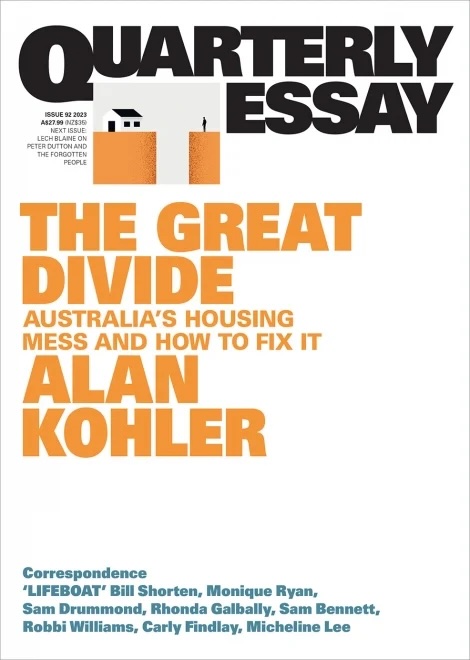
In The Great Divide: Australia’s Housing Mess and How to Fix It, Alan Kohler points out that “the solutions are both complex and simple, difficult and easy: supply must be increased and superfluous demand reduced”. Photo: Supplied.
After Hong Kong, Sydney’s median house price is the second most expensive on earth. An astonishing trend!
The hike in house prices is a sting that has transformed Australian society by escalating disparity and altering the relationship between generations. It was in the 21st century that things went seriously wrong, with a huge rise in the price of housing.
It’s no wonder, then, that one of the great mysteries of Australian life is that a land of sweeping plains, with one of the lowest population densities on the planet, has a shortage of land for houses.
Alan Kohler, a former editor of The Age and The Australian Financial Review, provides an in-depth analysis, stating “the solutions are both complex and simple, difficult and easy: supply must be increased and superfluous demand reduced”.
“The growth in the value of Australian land has fundamentally changed society, in two ways. First, generations of young Australians are being held back financially by the cost of shelter, especially if they live somewhere near a CBD and especially in Sydney or Melbourne; and second, the way wealth is generated has changed.
“Education and hard work are no longer the main determinants of how wealthy you are; now it comes down to where you live and what sort of house you inherit from your parents. It means Australia is less of an egalitarian meritocracy.”
In this sharp, illustrative and progressive essay, Kohler tells the story of how we got into this mess – and how we might get out of it – complete with graphs.
In 1980, when Alan and his wife bought their first house, they paid roughly the median house price of $40,000. As well, they also paid about 3.5 times his salary for the house, although they were better off than his parents because his wife was working.
“Workforce participation for thirty-year-old women had increased from 32 to 50 per cent by 1980 as a result of the social/sexual revolution of the 1960s and ’70s,” he said.
“Over the past four years, our children and their partners all bought their own first houses. They’re doing it later than we did, and much later than my parents, so they’re making better money, and both partners are working, of course, but they paid about 7.5 times each income for their houses. That was typical: in August 2023, the median Australian house price was $732,886, which was 7.4 times annualised average weekly earnings.
“In other words, my children – and all young people today – are paying more than twice the multiple of their income for a house than their parents – and their grandparents – did, and it’s only vaguely possible because both partners work to pay it off.”
What happened, and when it all happened, is concisely outlined in QE92: the problem started with the new millennium. It is impossible to overstate the significance to Australian society of what happened then.
In recent years, interest rates have been the main thing determining house prices. Reading about what happened more than two decades ago is informative. As explained, three main things pushed up demand for housing after 2000: a sharp immigration lift that increased the number of people needing a place to live; capital gains tax breaks and negative gearing, which represent a $96 billion-a-year subsidy for buying houses; and federal first-home buyer grants, which represent a $1.5 billion direct addition to house prices each year.
As Kohler explains: “… the nitro of a surge in demand around that time mixed with the existing glycerine of restricted supply to create an explosion that has blown up the Australia that our parents knew.”
The fundamental issue is that Australian homes have simply become too expensive for society to work normally. So, the bottom line is that Australian capital-city housing is too expensive compared with incomes for a healthy society, and that needs to change.
In this well-researched essay, Kohler says what is required is active, and serious, government intervention. Not another inquiry or a royal commission, but a “good start” would be a taskforce drawn from Treasury and the housing department to go through the work that’s been done already and come up with a policy that has a clear aim and is likely to work.
By Alan Kohler, Quarterly Essay/Black Inc, $27.99



